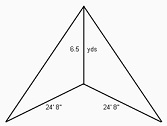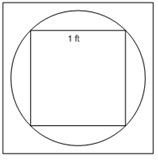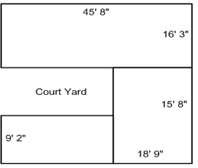Assignment:
Working with Pythagoras theorem
A Little League team is building a backstop for its practice field. It is made up of two right angles as shown below. The backstop extends 24 feet 8 inches out in each direction and the center pole is 6.5 yards high. All sides of the backstop including base and the center pole are to be made of aluminum tubing. How many feet of tubing should the team buy? How many square feet of the backstop must be covered by a screen?

Answer- This problem utilizes some simple geometry concepts.
To find how many feet of tubing required we need to know the lengths of all sides. This can be determined using Pythagoreans theorem.
A2 + B2 = C2
Where A and B are 24'8" and 6.5 yds (remember to convert both to similar units....probably inches would be best). Then simply add all the sides together.
The second part involves area of a triangle.
Area of triangle = 1/2 * base * height
But because we have two equal triangles this becomes 2 times that giving...
Area = base * height (remember to convert your units again)
An Indian sand painter begins his picture with a circle of dark sand. He then inscribes a square with a side length of 1 foot inside the circle. What is the area of the circle?

To find the area of the circle we need to know the diameter (or radius) of the circle. If we look at the diagram we see this is just the diagonal line connecting one corner of the square to the other. If we draw this line we form two equal triangles. The diagonal line will be the hypotenuse. We can use Pythagoreans Theorem like we did above.
In this case 12 + 12 = C2 so C = 1
Then use the formula for are of a circle.
Area circle = pi * R2
Where pi = 3.14 and R (radius) = one half the diameter, or 0.5.
Three buildings abut as shown in the diagram below. What are the dimensions of the courtyard and what is the perimeter of the building?

To find the area of the courtyard look at the length of all the different sides. We'll say x is the horizontal (long) side of the courtyard and y is the vertical (short) side of courtyard.
If we exam all sides we see that...
45'8" - 18'9" = x
15'8" - 9'2" = y
Additional question - To answer the question shouldn't I add x and y to get the dimensions of the courtyard?
To find the perimeter, add up all sides around the edge of the building. Or in other words..
2(45'8") + 2(16'3" + 15'8") = perimeter
Additional question - Why wouldn't the 18"9 and the 9"2 be included in the formula to get the perimeter?
A cylindrical can is just big enough to hold three tennis balls. The radius of a tennis ball is 5 cm. What is the volume of air that surrounds the tennis balls?
To determine the volume of air we need to know two things, the volume of all three tennis balls and the volume of the cylindrical can.
Volume of (sphere) tennis ball = 4/3 * pi * R3
Where pi = 3.14 and R (radius) = 5/2 cm = 2.5 cm (Why is this included)
Volume of Cylinder = height * area of bottom
Area of bottom equals a circle with radius 2.5 cm so... (??)
Area of bottom = pi * R2
Height = 3 * 5cm = 15cm (Why would a fellow student suggest 30cm)
Once you know both the volume for the tennis balls and the volume for the cylindrical can you can just subtract the balls from the can to find the volume of air.
Additional question - Since area is measured in square inches, square ft etc wouldn't the answer need to be converted?
Volume air = Volume Cylinder - Volume tennis balls